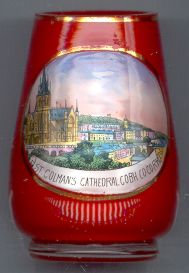

|
| IRELAND / ÉIRE |
| County Cork / Contae Chorcaí |
 The Irish port town of Cobh is situated on the southern shore of the Great Island in the natural bay of
Cork harbour, on slopes overlooking the harbour. Cobh has a population of about 10,000 (2002).
The Irish port town of Cobh is situated on the southern shore of the Great Island in the natural bay of
Cork harbour, on slopes overlooking the harbour. Cobh has a population of about 10,000 (2002).
The place had had many different Irish names before it was mentioned for the first time as Cove of Cork in 1750. In 1849 it was renamed Queenstown to commemorate a visit by Queen Victoria. With the foundation of the Irish state in 1922, the name Cobh was introduced as a way of 'gaelicising' the previous English placename 'Cove', as many Irish placenames had been anglicised by English settlers before. The word 'cobh', however, has no meaning in the Irish language. One of the major transatlantic Irish ports, Cobh was the point of departure for 2.5 million of the 6 million Irish people who emigrated to North America between 1848 and 1950. With the Anglo-Irish Treaty of 1921 the port of Cobh became a UK sovereign base until it was handed back to Ireland after the Anglo-Irish Free Trade Agreement in 1938.
A number of notable ships are associated with Cobh: The first steamship to sail from Ireland to England left Cobh in 1821. The "Sirius", the first steamship to cross the Atlantic, left Cobh in 1838. On 11 April 1912 Cobh was the final port of call for the RMS "Titanic" before she set out across the Atlantic on her ill-fated maiden voyage. The RMS "Lusitania" was sunk by a German U-Boat while en route to Cobh in 1915.
 St. Colman's cathedral [left], the seat of the Roman Catholic diocese of Cloyne, is located on the top of
the hill overlooking the town. The church was built in French Neo-Gothic style from 1868 until 1916.
It is dedicated to St. Colman (522–604) who founded the diocese in 560 AD.
In 1916 a carillon of 42 bells was installed; five more bells were added in 1958. Today the carillon consists of 49 bells.
The largest bell, named St. Colman is 200 feet (61 m) above the ground and
weighs 3.6 tons; it is Ireland's largest bell. The carillon is the largest in Ireland and Britain.
St. Colman's cathedral [left], the seat of the Roman Catholic diocese of Cloyne, is located on the top of
the hill overlooking the town. The church was built in French Neo-Gothic style from 1868 until 1916.
It is dedicated to St. Colman (522–604) who founded the diocese in 560 AD.
In 1916 a carillon of 42 bells was installed; five more bells were added in 1958. Today the carillon consists of 49 bells.
The largest bell, named St. Colman is 200 feet (61 m) above the ground and
weighs 3.6 tons; it is Ireland's largest bell. The carillon is the largest in Ireland and Britain.
![[scale]](lineal.jpg)